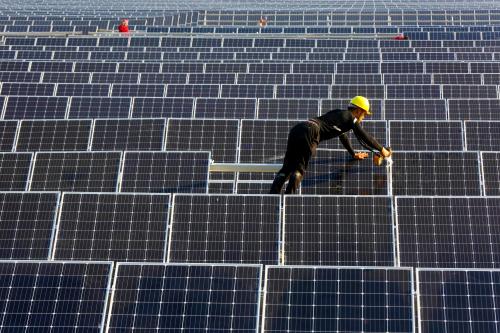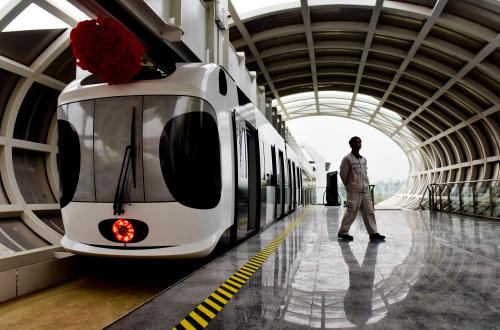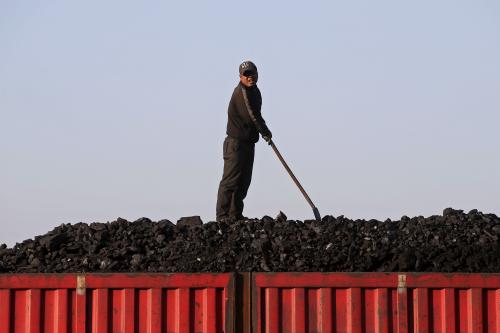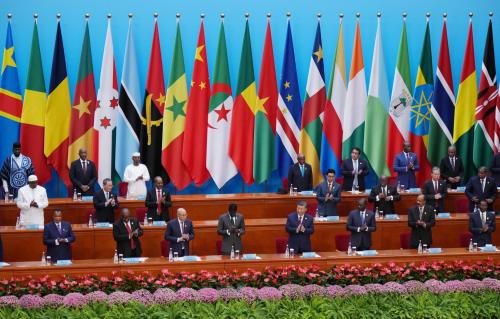Content from the Brookings-Tsinghua Public Policy Center is now archived. Since October 1, 2020, Brookings has maintained a limited partnership with Tsinghua University School of Public Policy and Management that is intended to facilitate jointly organized dialogues, meetings, and/or events.
With the conclusion of China’s “two sessions,”—the 5th Sessions of the 12th National People’s Congress (NPC) and the 12th National Committee of the Chinese People’s Political Consultative Conference (CPPCC), respectively—Brookings experts weigh in with insights into the future of China’s social and economic development.
David Dollar, Senior fellow, John L. Thornton China Center of the Brookings Institution
I pay a lot of attention to premier’s work report, and then the speeches from the head of the central bank, ministry of finance and National Development and Reform Commission (NDRC), because I think there are some question marks about China’s macroeconomic policy right now. A lot of debt is being built up in the Chinese economy, and Chinese officials talked about this. The only way to get that under control is to tighten up monetary policy and slow down the growth of credit. And that might bring down the growth rate a little bit. So, what’s the target growth rate? And there are measures that can counteract that. I think China needs to stimulate consumption. So, I am going to look for those more macro-focused speeches that help illuminate the details of monetary and fiscal policies, as well as structural reforms. (This is adapted from a piece published on China Daily.)
Cheng Li, Director and senior fellow, John L. Thornton China Center of the Brookings Institution
This is a very important year to implement economic policies—especially the deepening of economic reforms as laid out in the Third Plenum—before the 19th National Congress of the Communist Party of China.
As we know, the two sessions usually pay attention to people’s livelihoods. I think the deepening of economic reforms reflects broad concern about how to improve people’s livelihoods, especially expanding China’s middle class.
Despite concerns that some of the policies are not fully implemented, we should also look at the fact that domestic consumption is up, and the service-sector environment is very dynamic. Moreover, innovative startup companies by college students are becoming widespread, especially in major cities—Shanghai, Shenzhen, Beijing, and elsewhere. These represent very important developments.
Hopefully, there will be more positive news about the further implementation, or deepening, of reforms that will pave the way for accelerating some programs. (This is adapted from a piece published on China Daily.)
Qi Ye, Director, Brookings-Tsinghua Center for Public Policy; Professor, School of Public Policy and Management, Tsinghua University
China has made far more progress in its energy transition than expected. The country’s energy transition and energy revolution aims at achieving three targets: efficiency, low-carbon emissions and clean consumption. Energy intensity, carbon intensity, and the share of clean energy are key indicators of China’s energy transition.
Premier Li Keqiang pointed out in his annual report at the recent National People’s Congress that China’s energy intensity fell by 5 percent and the share of clean energy consumption increased by 1.7 percent in 2016. Furthermore, data show that carbon intensity decreased by nearly 7 percent. These rates—in the growth of China’s energy efficiency, carbon productivity, and the rise in the share of clean energy consumption—have rarely been seen in world history.
During the 12th Five-Year Plan, China exceeded both its energy intensity and carbon emission targets, while also surpassing the clean energy target. At the outset of the 13th Five-Year-Plan, China maintained the momentum of its energy transition, improving in all three sectors: energy efficiency, low-carbon emission, and cleaner energy consumption. It is heartening that both the amount and the share of coal in its energy structure have dropped drastically, signaling China’s steady progress in a post-coal growth era.
Finally, in an effort to address climate change, China will not only exceed the targets set for the Copenhagen Accord, but also lay a solid foundation towards achieving those set by the Paris Agreement.
Hu Min, Nonresident senior fellow, Brookings-Tsinghua Center for Public Policy
I have been following the discussions on issues of energy, environment, and climate change at the “two sessions.” In the past few years, many members of the NPC and CPPCC have put forward proposals concerning both the environment and energy, and we have witnessed the approval and implementation of the Atmospheric Pollution Prevention and Control Law, the Environmental Protection Law and the Environmental Protection Tax Law. I believe there will be more heated discussions on these issues this year.
I also pay a lot of attention to topics of de-capacity, economic restructuring and urban development, as they are part of macroeconomics’ core strategy and play determining roles in environment and energy development. In fact, I consider these topics even more important than the implementation of environmental regulation. I am happy to see the data for energy conservation and emission reduction in this year’s government work report, and I believe that the government’s steady economic stimulus plan will have long-term, positive impacts on China’s transition towards a green economy.
Yu Ning, Fellow and research director, Brookings-Tsinghua Center for Public Policy
Having been a keen observer of rural China, I applaud President Xi Jinping’s pragmatic approach in warning local officials against competing to end China’s poverty ahead of schedule. I also support the “Five Batches” anti-poverty guideline, which is philosophically consistent with the proverb of “teach a man to fish and you feed him for a lifetime.” This guideline—found in Premier Li Keqiang’s government work report—aims to reduce poverty through production, relocation, ecological compensation, education, and social security. The first four components intend to change the environments that fuel poverty and to promote equal opportunities, so that people could improve their living conditions through their own efforts. The fifth component reserves an unconditional social safety net for those truly in need, through limited transfer payments.
This guideline is formulated in accordance with the stage of China’s social and economic development, and will prevent people from digging their own poverty traps out of concerns of losing welfare. Engineering thinking is insufficient when designing policy, because unlike steel and cement, people can adapt their behavior to policy changes. The key to successful policymaking oftentimes lies in shaping those behaviors.
The Brookings Institution is committed to quality, independence, and impact.
We are supported by a diverse array of funders. In line with our values and policies, each Brookings publication represents the sole views of its author(s).











Commentary
Experts weigh in: What came out of China’s “two sessions”
March 16, 2017